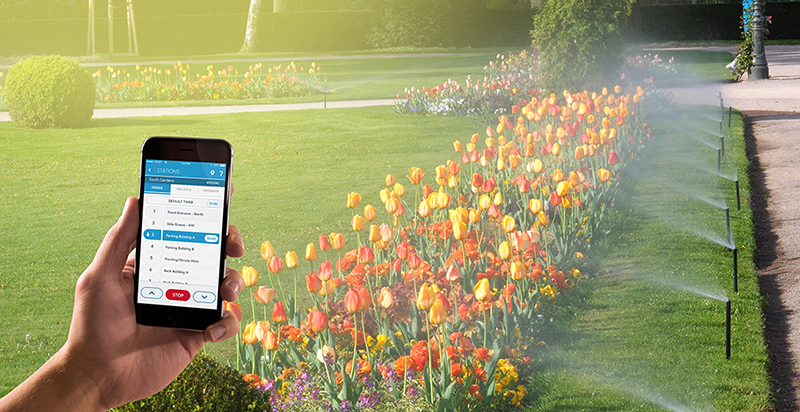What Is Smart Irrigation?

In the United States, outdoor water use alone averages more than 9 billion gallons of water each day, mainly for landscape irrigation. As much as 50% of this water is wasted due to overwatering caused by inefficiencies in traditional irrigation methods and systems. Smart irrigation technology is the answer.
Smart irrigation systems tailor watering schedules and run times automatically to meet specific landscape needs. These controllers significantly improve outdoor water use efficiencies.
Unlike traditional irrigation controllers that operate on a preset programmed schedule and timers, smart irrigation controllers monitor weather, soil conditions, evaporation and plant water use to automatically adjust the watering schedule to actual conditions of the site.
For example, as outdoor temperatures increase or rainfall decreases, smart irrigation controllers consider on site-specific variables, such as soil type, sprinklers’ application rate, etc. to adjust the watering run times or schedules. There are several options for smart irrigation controllers.
The Difference Between Weather-Based and Soil Moisture Sensors
Essentially there are two types of smart irrigation controllers: weather-based (ET) and on-site soil moisture sensors. The right solution depends on your geographic location and landscape environment.
Weather-based smart irrigation controllers
Weather-based controllers, also referred to as evapotranspiration (ET) controllers, use local weather data to adjust irrigation schedules. Evapotranspiration is the combination of evaporation from the soil surface and transpiration by plant materials. These controllers gather local weather information and make irrigation run-time adjustments so the landscape receives the appropriate amount of water.
ET weather data uses four weather parameters: temperature, wind, solar radiation and humidity. It’s the most accurate way to calculate landscape water needs.
There are three basic forms of these weather-based ET controllers:
- Signal-based controllers use meteorological data from a publicly available source and the ET value is calculated for a grass surface at the site. The ET data is then sent to the controller by a wireless connection.
- Historic ET controllers use a pre-programmed water use curve, based on historic water use in different regions. The curve can be adjusted for temperature and solar radiation.
- On-site weather measurement controllers use weather data collected on-site to calculate continuous ET measurements and water accordingly.
Soil moisture sensors used with smart irrigation controllers
Soil moisture sensor-based smart irrigation controllers use one of several well-established technologies to measure soil moisture content. When buried in the root zone of turf, trees or shrubs, the sensors accurately determine the moisture level in the soil and transmit this reading to the controller.
There are two different soil moisture sensor-based systems available:
- Suspended cycle irrigation systems, which are set like traditional timer controllers, with watering schedules, start times and duration. The difference is that the system will stop the next scheduled irrigation when there is enough moisture in the soil.
- Water on demand irrigation requires no programming of irrigation duration (only start times and days of the week to water). It has a user-set lower and upper threshold, which initiates irrigation when the soil moisture level fails to meet those levels.
Smart Irrigation Controllers Save Water and Money
The experts agree that smart irrigation systems and controllers versus traditional irrigation controllers conserve water across a variety of scenarios. Several controlled research studies indicate substantial water savings anywhere from 30 to 50 percent.
Tests by the Irrigation Association (IA) and the International Center for Water Technology at California State University in Fresno, have shown smart irrigation controllers to save up to 20 percent more water than traditional irrigation controllers.
Another study tested a prototype controller/receiver system consisting of a traditional irrigation controller modified to receive a signal broadcasted via satellite. Outdoor water savings were calculated based on 2-years of pre-installation usage and were adjusted for weather conditions. The reported average outdoor savings is 16 percent and it is also reported this represents 85 percent of potential savings based on reference ET.
A water efficient irrigation study of the Saving Water Partnership, a coalition of 24 water purveyors, was conducted in Washington State’s Puget Sound. Water savings were calculated based on historical consumption and adjustments were made for weather conditions. The reported water savings were 20,735 gallons per year per site for sites with rain sensors controllers and 10,071 gallons per year per site for sites using traditional controllers.

